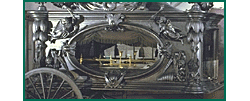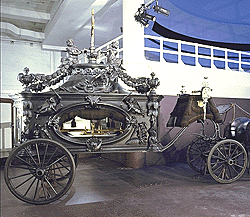
![]()
Horse-Drawn Hearse
Gauthier et Fils; Trois-Rivières, Quebec; ca. 1898; height (including cross): 429.5 cm. CMC 983.10.1 a-k
Carriagemaker Félix Gauthier of Trois Rivières, Quebec, built this magnificent three horse hearse in 1898 for his funeral parlour, Gauthier et Fils. He used it to deliver deluxe funerals to both the high-and the low-born throughout the year; in winter the wheels were replaced with runners. The hearse was furnished with black curtains for adults and white for children.
The symbolic, decorative elements, which were made by an unknown woodcarver from Montreal, are closely associated with the Roman Catholic funeral ceremony. Crossed scythes, a sign of death, are found on the sides. Humans in a garden of ferns, palms, and bulrushes provide a glimpse of Paradise.

Palm trees, which form the corners of the hearse, are symbolic of Christ's victory over sin and death. Angels holding a torch in each hand rise above the Paradise. The torches may perhaps symbolize Jesus Christ as the light of the world. Lit urns, placed on top of the hearse at each corner, signify wisdom and religious devotion. On either side, a grieving woman holds in her right hand the sign of eternity: a crown of laurel leaves. With her left, she leans on a book, representing the Scriptures. Two cherubs lift up the crown of victory surmounted by the cross of redemption and salvation.

The pomp and ceremony associated with the hearse illustrate the importance with which Quebec society viewed death at the end of the nineteenth century. In addition to being a major piece of Quebec sculpture from that period, this hearse is a rare example of a vehicle of its type that retains most of its original, ornately carved decorations.

